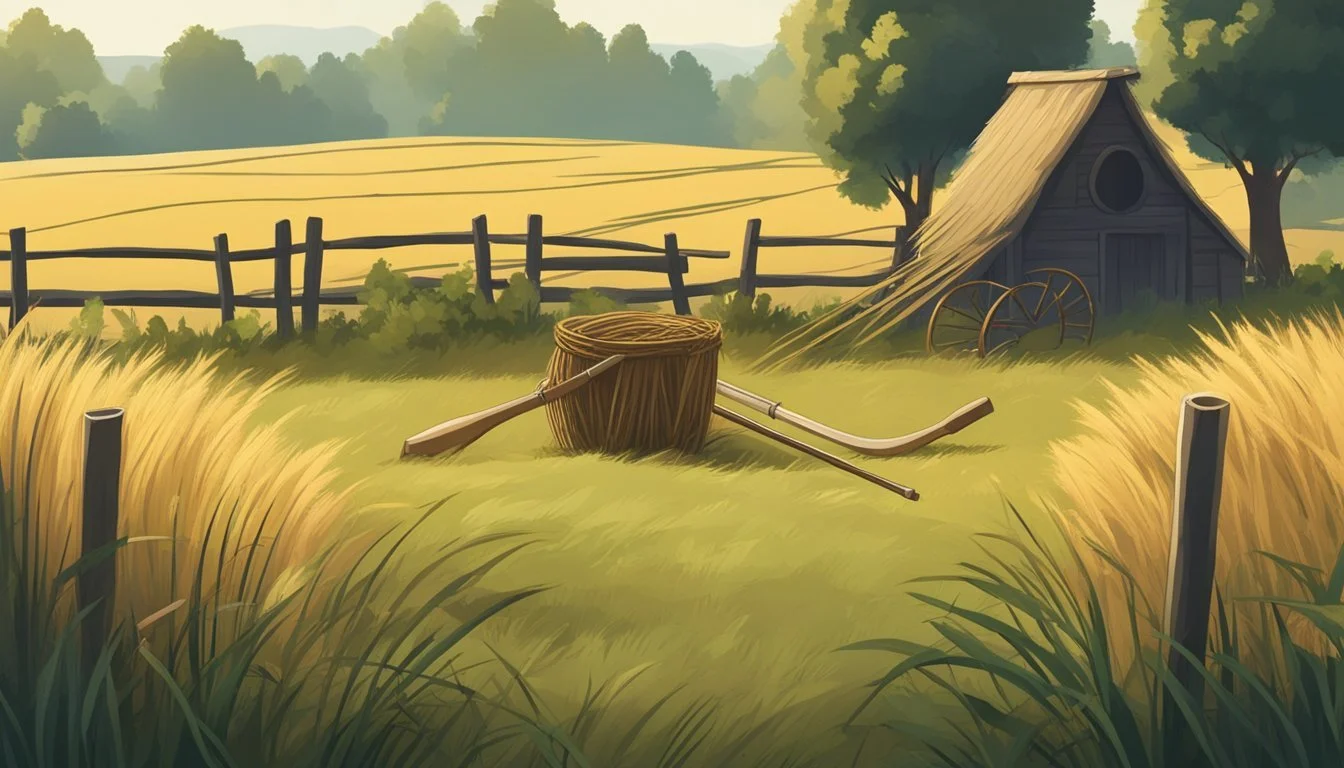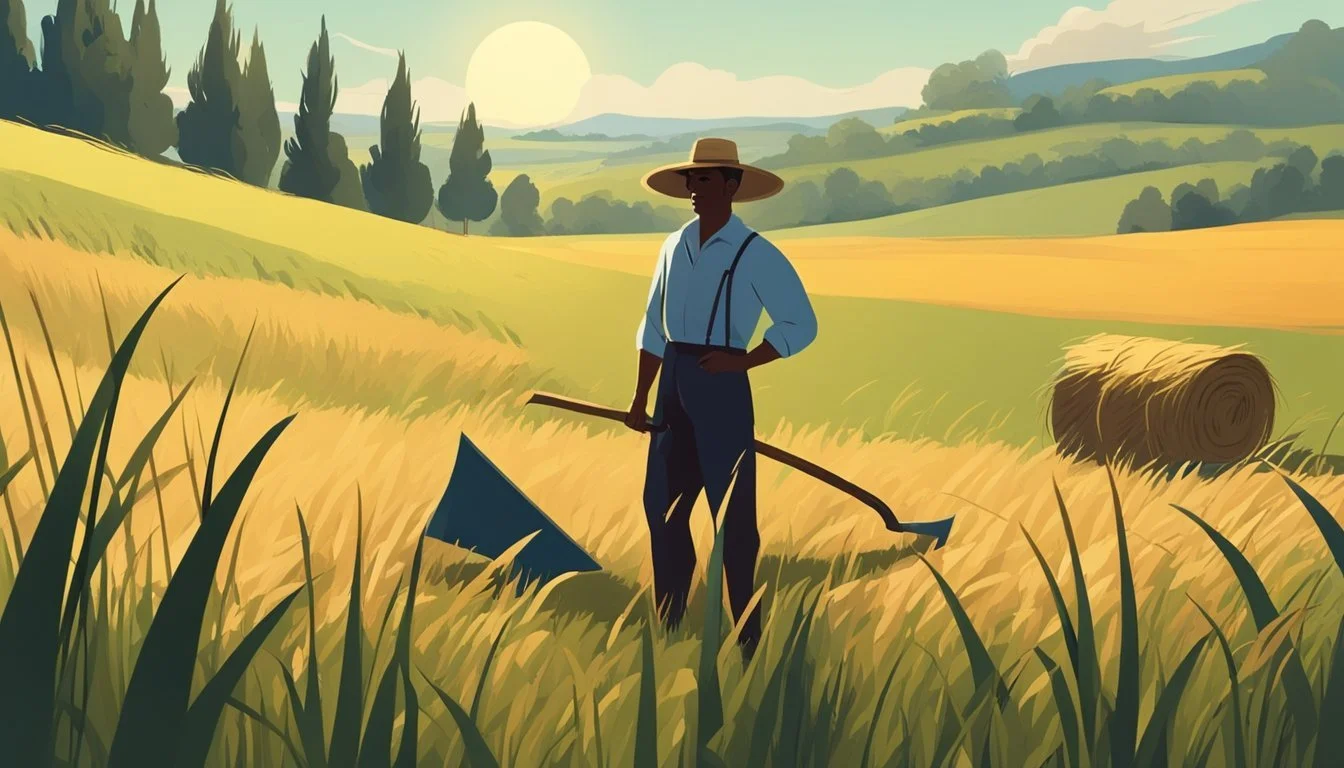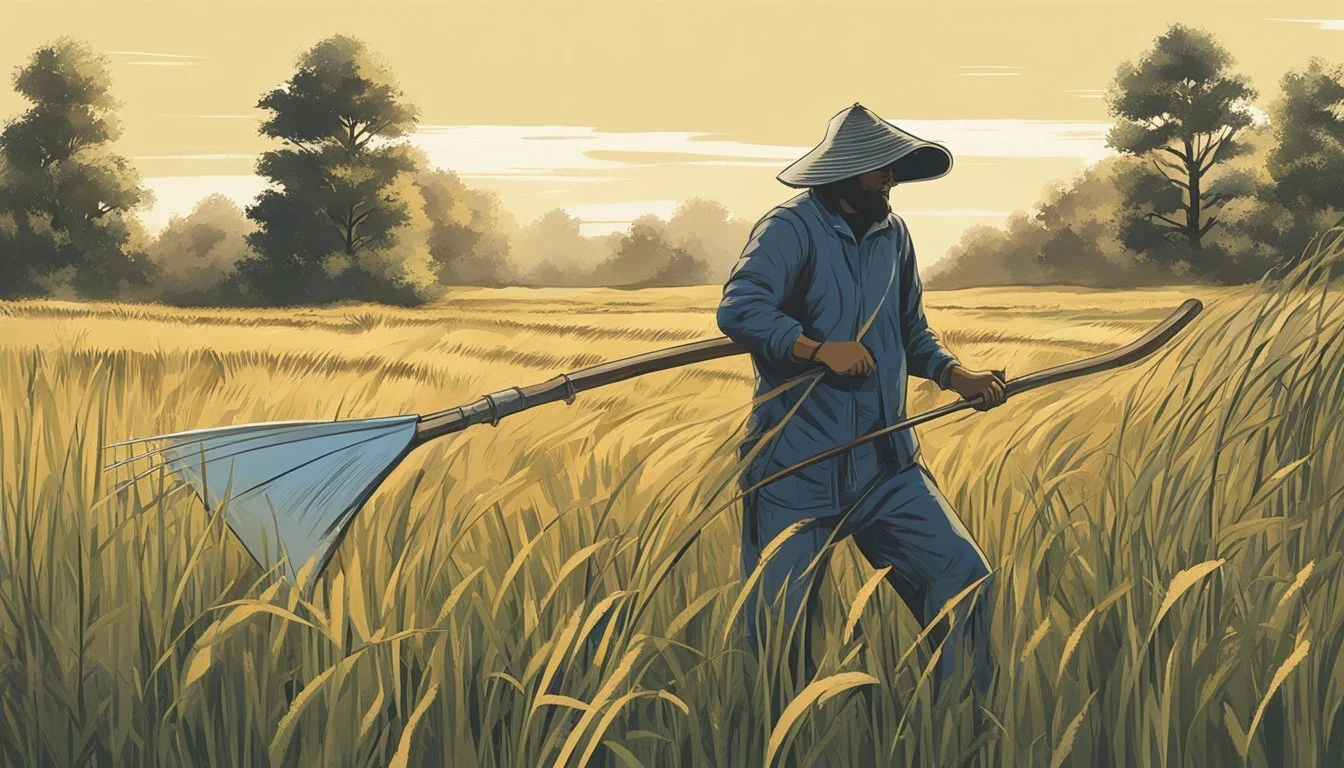The Art of Scything and Traditional Haymaking
Reviving Time-Honored Techniques
The art of scything and traditional haymaking embodies a rich heritage of agricultural practices that have been pivotal in farming history. Scything, a method that employs a long, curved blade attached to a handle called a snath, is an ancient technique of cutting grass or reaping crops. The simplicity and effectiveness of this tool made it a fundamental element in agricultural societies before the advent of mechanized farming. Scything requires skill and rhythm, enabling the user to slice through vegetation with minimal disruption to the environment, making it not only efficient but also eco-friendly compared to modern gas-powered mowers.
Haymaking, the process of converting fresh-cut grass into hay, is crucial for creating winter fodder for livestock. It is an intricate dance of cutting, drying, and stacking, all timed with an attentive eye to weather patterns. Where modern machinery has overtaken many traditional methods, haymaking by hand preserves the integrity of the grass and often yields a superior product. Engaging in these traditional methods connects practitioners to the seasonal rhythms of the land and to the heritage of past generations who relied on these skills for their livelihood.
Despite the advancements in agricultural technology, the traditional methods of scything and haymaking have experienced a resurgence among small-scale farmers, conservationists, and those seeking a more sustainable way of life. The resurgence of these practices is not just about nostalgia; it is about adopting a more harmonious approach to land management that favors the health of the ecosystem over convenience. They serve as a testament to the enduring value of learned technique, the importance of environmental stewardship, and the desire to maintain a physical and spiritual connection to the land.
History and Evolution of Haymaking
Haymaking, the process of converting fresh grass into storable fodder for livestock, has significantly evolved from primitive sickle tools to the advanced scythes and techniques observed today.
Origins of Haymaking
Haymaking began in agrarian societies as a fundamental practice for preserving grasses and other plants to feed animals during times when live forage was unavailable. Early methods involved manual collection of grasses using basic hand tools. The sickle, a curved blade, was among the first instruments used for this purpose, especially before the introduction of more efficient tools.
Development of the Scythe
The scythe, with its long curved blade and snath (handle), represented a more productive advancement over the sickle. In Austria and surrounding regions, evidence suggests that the scythe became popular for cutting hay around the 12th century. It was around the 16th century that the scythe started being used for harvesting not just hay but also crops like wheat. The introduction of the patent for the grain cradle, which added fingers to the scythe to catch the cut grain, further enhanced the efficiency of this tool.
Traditions Across Cultures
Haymaking techniques and tools varied from place to place, often reflecting cultural practices and the demands of the local environment. In regions like Germany, specific patterns and methods for cutting, drying, and stacking hay were developed. These processes were not just about efficiency, but also about the sustainable management of the land and community cooperation within agricultural societies. The scythe itself has also undergone changes, with improvements in materials from the original iron blades to the more durable alloys used today.
The Scythe: Anatomy and Types
The scythe is a time-honored agricultural tool with a distinctive anatomy and comes in various types to suit different tasks and vegetation. Below, we explore the specific components that contribute to its functionality and the different styles adapted over time.
Parts of a Scythe
The scythe consists of a long, typically curved blade and a snath, which is the long handle that accommodates both hands and aids in the tool's sweeping motion. The top end of the snath usually has a horizontal handlebar for the left hand, called a grip or hilt. The bottom end may have another handle for the right hand, ensuring greater control and leverage.
Blade – The cutting edge, it’s thin and made of steel, sharpened to a fine edge suitable for slicing through grass or crops.
Snath – Made from wood or lightweight metals, the snath is essentially the long handle. It's ergonomically shaped to distribute the workload across the body evenly.
Tang – This part connects the blade to the snath. A secure tang ensures the blade's stability during the scything motion.
Different Types of Scythes
Austrian Scythe – Known for its lightweight and thin blade, the Austrian scythe is valued for its efficiency and is widely used for cutting grass and wildflowers.
Bush Scythe – With a thicker blade, the bush scythe is designed to clear undergrowth and woody material, not just grass.
The types of scythes reflect the diverse needs from agricultural practices to managing wild green spaces. Each type adopts a shape and build optimized for its intended use, from the precise cutting of grains to managing bushlands.
Preparing for Scything
Proper preparation is crucial when it comes to scything. To ensure effectiveness and safety, one must select the right scythe, measure for a proper fit, and sharpen the blade before beginning this traditional task.
Choosing the Right Scythe
Scything requires a tool that suits the user's specific needs. A traditionally-shaped European scythe is often preferred for its efficiency and ease of use. The scythe is comprised of the blade and a snath (handle) which may be straight or have a subtle S-curve, depending on the design. It's important to choose a scythe of the correct size and style for the intended task.
Measuring for Proper Fit
To minimize fatigue and maximize cutting power, the scythe must align with the user's body measurements. This is done by standing with the snath against one's body and ensuring that the grips are at hip height and just below the shoulder, respectively. This will facilitate a natural, upright posture while scything.
Sharpening the Blade
A sharp blade is a safe blade. Sharpening is done through a process called whetting, which should be done frequently to maintain a keen edge. Begin by using a whetstone to file the blade at the correct angle, moving from the heel to the toe of the blade. A well-sharpened blade makes scything more efficient and reduces wear on the body.
Mowing Technique and Posture
Mastering the art of scything demands attention to technique and posture, with the goal of creating efficient and clean cuts through the swath. It is an exercise in precision, where the sharpness of the blade and the motion of the body align to utilize both power and grace.
Basic Scything Technique
When a beginner starts to learn scything, the primary focus is on developing a proper stance and motion. The mower stands with feet shoulder-width apart, holding the scythe in a way that the top hand grips near the top end of the snath and the lower hand closer to the middle. The blade should be kept sharp to ensure effectiveness and reduce the need for excessive force. The basic motion resembles that of certain forms of yoga or tai chi, requiring smooth, sweeping hip-led movements. It's about mindfulness and maintaining a focus on consistent, even strokes that cover the same amount of ground to each side.
Step forward with the leading foot, which is opposite the side you are cutting.
Swing the scythe in a long arc, moving from the hips, keeping the spine neutrally aligned.
Complete the stroke with a slight upward flick to clear the cut grass from the blade.
Advanced Mowing Strategies
As one progresses from basic scything to more advanced techniques, speed and patterns in cutting become more significant. Experienced mowers adjust their posture and rhythm to accommodate various types of terrain and vegetation density. While maintaining a sharp blade remains crucial, advanced strategies also involve managing the size of the swath for optimal efficiency.
Engage the core muscles to support the back, combining strength with flexibility for extended mowing sessions.
Incorporate a pivot from the hips to increase the reach and smoothness of each stroke, allowing for a larger swath of grass to be cut with each movement.
Develop a tempo that balances speed with control to maximize efficiency while minimizing fatigue.
Advanced mowing may also include adjustments to the scythe setup, such as the angle of the blade or the height of the handles, to better suit the individual mower's body and the specific task at hand.
Haymaking: From Grass to Hay
Haymaking is a process that transforms green grass into hay, a storable feed for livestock. The method consists of two primary steps: cutting the grass and then drying and arranging it into haystacks.
Cutting the Grass
The initial step in making hay is mowing the grass. Traditionally, this task was performed using a scythe – a long, curved blade set on a long handle, or snath. The scythe allows for a clean, efficient cut close to the ground. It is essential that the mowing occurs on a dry day to prevent the growth of mold or mildew on the freshly cut grass.
Drying and Gathering Hay
Once cut, the grass is left to dry in the sunshine, turning it regularly to expose all surfaces to air and prevent rotting. This drying phase can take several days and relies heavily on dry, windy weather to proceed quickly. When the grass has sufficiently dried, it is then gathered into rows called windrows. Subsequently, it can be collected into large haystacks, either manually or using a horse rake, where it will continue to cure until it is needed. The hay must be completely dry before storage to prevent spoilage.
Maintaining Scything Tools
Proper care for scything tools is essential for their longevity and effectiveness. A well-maintained blade stays sharp and reduces the effort needed for cutting, while handle care ensures safety and comfort during use.
Routine Blade Maintenance
Sharpening the Blade: Regular sharpening is crucial for a scythe blade. Users should whet the blade with a whetstone before each use to maintain its sharpness. This involves:
Wetting the whetstone with water to reduce friction.
Holding the stone at a consistent angle to the blade's bevel.
Using smooth, circular motions to sharpen along the length of the blade.
Peening the Blade: Over time, the blade's edge may become too thin and require peening. This process reforms the metal, creating a wider edge for easier sharpening.
To peen a scythe blade:
Place the blade on a peening anvil or jig.
Gently tap with a peening hammer, working along the edge.
Handle Care and Repairs
Inspection and Repair: The handle, or "snath," should be inspected for cracks or wear before each use. Small cracks can be repaired with wood glue, while larger ones might require the handle to be replaced.
Oiling the Handle: To protect the wood from moisture and decay, users should:
Clean the handle with a damp cloth.
Apply a thin coat of linseed oil.
Allow it to dry thoroughly.
Maintaining the synergy between blade and handle ensures that the ancient art of scything remains both effective and enjoyable.
Advantages of Traditional Haymaking
Traditional haymaking utilizing the scythe is more than just an agricultural practice; it's a harmonization with nature that offers considerable benefits. This section delves into the environmental advantages, health and exercise enhancements, and socioeconomic impact of this time-honored method.
Environmental Benefits
Traditional haymaking is gentle on the environment. It preserves biodiversity by avoiding the habitat disturbance often caused by heavy machinery. Nature thrives as a variety of flora and fauna coexist in meadows maintained by scything. This method also reduces carbon emissions, as it relies on human power rather than fossil fuels. The maintenance of habitats in this traditional way supports a diverse range of wildlife, which can thrive in the undisturbed conditions.
Health and Exercise
Scything is a form of good exercise that works multiple muscle groups and has cardiovascular benefits. The rhythmic motion provides a low-impact but high-yield workout, enhancing the health of those who practice it. This method of haymaking promotes physical activity in the open air, which can lead to improved mental well-being.
Socioeconomic Impact
For farmers, the traditional method of haymaking offers a cost-effective alternative to mechanized tools. It fosters a sense of community as individuals come together to learn and practice this skill. This traditional way of working the land can support local economies, reduce financial barriers to entry for small-scale farmers, and preserve cultural heritage. Moreover, the experience of working closely with nature can strengthen the bond between people and the land they cultivate.
Modern Applications and Practices
Scything has transcended its historical roots and is now applied in contemporary settings for ecological land management, sustained agricultural productivity, and as a tool for education and community engagement.
Land Management and Ecology
In modern land management, scything is recognized for its environmental benefits. It plays a crucial role in maintaining meadows and wildflower meadows, enhancing biodiversity by promoting the growth of a variety of plants and providing habitats for insects and wildlife. Manual scything preserves the structure of the soil and avoids the carbon emissions associated with traditional machinery. Additionally, it's seen as a harmonious method to maintain the health and appearance of ornamental gardens and green spaces in a climate-conscious era.
Agricultural Use in Modern Farming
Contemporary farmers who emphasize sustainable practices often incorporate scything into their routine. In the harvest season, scything is not only used for haymaking but also for clearing weedy areas and managing cover crops. It minimizes the impact on the terrain when compared to heavier agricultural machinery and does not contribute to soil compaction, ensuring the long-term fertility and viability of the land. The efficiency and low cost associated with the practice are making it a preferred choice for small-scale farms and organic producers.
Community and Educational Workshops
Workshops on scything and traditional haymaking have gained popularity in community and educational circles. They serve as a platform for individuals to learn about scything techniques, engage with local agricultural traditions, and understand the ecological benefits of the tool. Offering both apprenticeship opportunities and workshops, these community gatherings create a space for experienced scythers to share their knowledge with novices and enthusiasts. This hands-on learning approach fosters a connection between people and the land, and inspires a new generation to value traditional methods in a modern world.
Cultural Significance and Revival
Scything, a traditional method of haymaking, has seen both a cultural perpetuation and a noteworthy renaissance. The practice holds a place not only in agricultural history but also in modern environmental and cultural movements.
Scything in Popular Culture
Scything has been portrayed as a symbol of pastoral life and rural traditions in various forms of media. It gained notable attention when depicted in television series and films, showcasing the elegance and skill involved in wielding the scythe. This exposure has contributed to a growing interest in the technique as part of cultural heritage.
The Renaissance of Scything
The resurgence of scything can be attributed to its environmental benefits and its connection to cultural heritage. Workshops are now frequently organized to teach this skill, and festivals celebrate the art, often set in picturesque wildflower meadows. These events provide hands-on experiences that emphasize the method's efficiency and its role in sustainable land management. The renaissance is motivated by a desire to maintain traditional methods and to support biodiversity in agricultural practices.
Conclusion
Scything and traditional haymaking stand as testaments to sustainable agriculture and a deep connection with the land. The simplicity of the scythe, a long, curved blade affixed to a snath, enables a low-tech yet efficient method of mowing vegetation. Its usage in modern homesteading links past and present, showing a reverence for time-honored techniques.
Haymaking with a scythe is more than a method; it is a ritual that requires skill and endurance. Those who practice this art form embrace the physical demands and the meditative rhythm it imparts. While mechanical alternatives exist, the scythe offers an eco-friendly and quiet solution to land management.
In a world where modern conveniences often reign, traditional haymaking through scything provides a heartening reminder of simpler times. It’s a craft where one can witness the tangible results of their labor and feel a sense of accomplishment in their harvest. This method is still alive today, not only preserved out of nostalgia but employed for its practical and ecological benefits.
The resurgence of scything in places like New Zealand and its continued practice in modern farming highlight a collective desire for sustainable living and environmental consciousness. It emphasizes the merit in preserving the knowledge of the past to enrich the future.










